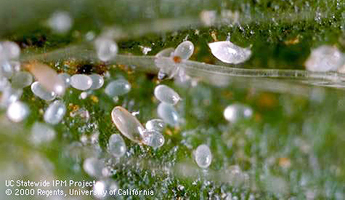|
|
Back to Pest Identification and Diagnosis
 |

|
|
|
Cyclamen Mites and Eggs From: University of California |
Life Cycle |
| DESCRIPTION | |
|
Adults: These mites are tiny animals, less than 0.3 millimeter long. Colorless or brown tinted and waxy looking, they have four pairs of legs. The fourth pair of the female is slender with a long, hair extending from the tip. The fourth pair of legs of the males ends in a strong claw.
Eggs: The elliptical egg is 0.1 millimeter long and smooth. Larvae: The young mites are about 0.2 millimeter long and are whitish and have three pairs of legs. The legs have microscopic claws and suction cups. Quiescent Stage: This stage appears as an immobile, engorged larva. |
|
| BIOLOGY | |
|
Host Plants: African violets are most often damaged by cyclamen mites. They also have been found on ivy, snapdragon, chrysanthemum, larkspur, geranium, fuschia, begonia, petunia, daisy, and azalea.
Damage: Cyclamen mites cause tuberous begonia and cyclamen flowers to be discolored or to shrivel or wilt. Infested flowers may not open properly or may not open at all. The mites also cause puckering, crinkling, and curling of leaves; infested leaves become brittle. Infested cyclamen buds fail to open or the flowers are distorted. Life Cycle: Cyclamen mites were first reported in the United States about 1900. It has since become famous as a harmful plant pest. Cyclamen mites seem to avoid the light; they occur in hidden areas on plants (buds and between the calyx and corolla and the stamens and ovaries of flowers). This mite also prefers high humidity. The eggs have delicate shells that can often be found collapsed among masses of unhatched eggs and mites. Deposited in moist, dark places and in small groups, the eggs require about 11 days to hatch. The mites molt only once. |
|
| MANAGEMENT STRATEGIES | |
|
Cultural control: Immersing infested plants (pot and all) into water heated to 43° C for 15 minutes kills cyclamen mites without harming most plants.
Pesticides: If chemical control is desired, spray or dip the plant thoroughly with a miticide. For specific chemical control recommendations, consult the Cooperative Extension Service. |
Back to Pest Identification and Diagnosis
 |
(C) Regents of the University of
Minnesota. All rights reserved. |
 |
 |